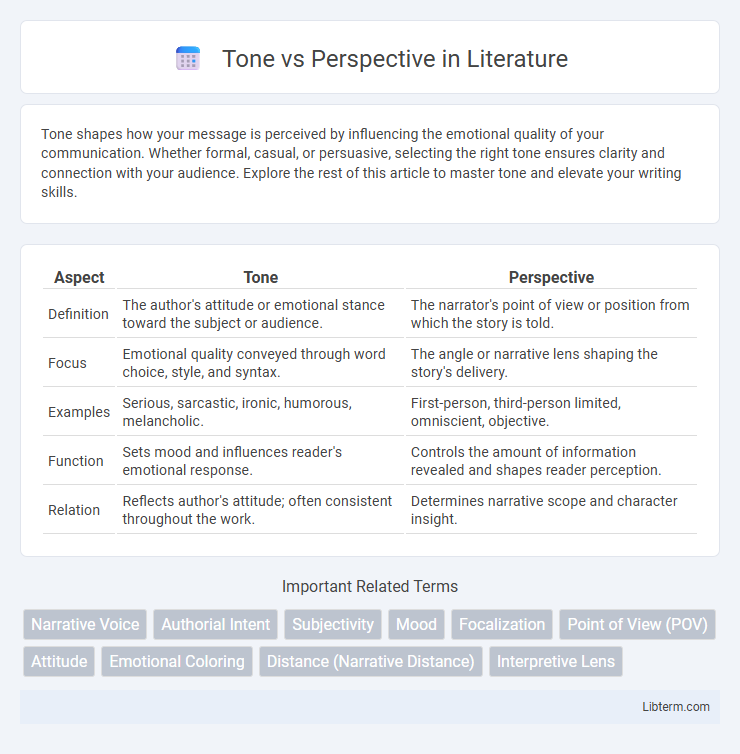Tone shapes how your message is perceived by influencing the emotional quality of your communication. Whether formal, casual, or persuasive, selecting the right tone ensures clarity and connection with your audience. Explore the rest of this article to master tone and elevate your writing skills.
Table of Comparison
| Aspect | Tone | Perspective |
|---|---|---|
| Definition | The author's attitude or emotional stance toward the subject or audience. | The narrator's point of view or position from which the story is told. |
| Focus | Emotional quality conveyed through word choice, style, and syntax. | The angle or narrative lens shaping the story's delivery. |
| Examples | Serious, sarcastic, ironic, humorous, melancholic. | First-person, third-person limited, omniscient, objective. |
| Function | Sets mood and influences reader's emotional response. | Controls the amount of information revealed and shapes reader perception. |
| Relation | Reflects author's attitude; often consistent throughout the work. | Determines narrative scope and character insight. |
Understanding Tone and Perspective
Understanding tone involves recognizing the author's attitude or emotional stance conveyed through word choice and style, which influences how the message is perceived. Perspective refers to the viewpoint or lens through which the story or information is presented, shaped by the narrator's background, experiences, and biases. Distinguishing between tone and perspective enhances comprehension by clarifying the emotional undercurrent and narrative angle in texts.
Defining Tone in Writing
Tone in writing refers to the author's attitude or emotional stance toward the subject or audience, conveyed through word choice, sentence structure, and stylistic elements. It shapes the reader's perception by creating an atmosphere that can be formal, informal, optimistic, sarcastic, or melancholic, among other emotions. Understanding tone is essential for effective communication, as it influences how messages are interpreted and the overall impact of the text.
What is Perspective?
Perspective refers to the viewpoint or stance from which a story or information is presented, shaping how events and characters are perceived by the audience. It involves the narrator's position, whether first-person, second-person, or third-person, influencing the depth of insight and emotional connection. Understanding perspective helps clarify the reliability, bias, and scope of the narrative, distinguishing it from tone, which conveys the mood or attitude.
Key Differences Between Tone and Perspective
Tone refers to the author's attitude or emotional stance conveyed through word choice and style, while perspective denotes the narrator's or character's point of view shaping how a story is told. Tone influences the mood and emotional impact on the reader, whereas perspective determines the angle and depth of information presented. Understanding these distinctions is crucial for interpreting literary works and analyzing narrative techniques effectively.
How Tone Shapes Reader Experience
Tone influences the reader's emotional response by conveying the author's attitude through word choice, sentence structure, and stylistic elements. A consistent, well-crafted tone establishes mood and atmosphere, guiding readers to interpret the narrative's meaning and significance more deeply. Variations in tone can alter the perceived message, making the reading experience more engaging or dissonant depending on the intended effect.
The Role of Perspective in Storytelling
Perspective shapes the narrator's viewpoint, influencing how events and characters are portrayed in storytelling. It determines the angle and depth of the narrative, affecting readers' empathy and understanding. By selecting first-person, third-person omniscient, or limited perspectives, writers control the emotional connection and information flow within the story.
Examples of Tone vs Perspective
Tone reflects the author's attitude or emotion toward the subject, such as sarcasm in a sarcastic review or enthusiasm in a promotional article, while perspective represents the narrator's position or viewpoint, like first-person in an autobiographical story or third-person omniscient in a novel. For example, in Harper Lee's *To Kill a Mockingbird*, the tone is reflective and serious, highlighting social injustices, whereas the perspective is that of Scout Finch, a young girl narrating her experiences. A news report may have a neutral, factual tone but adopt a third-person perspective, presenting information without personal bias.
Common Mistakes When Distinguishing Tone and Perspective
Confusing tone with perspective often leads to misinterpretations in analyzing texts, as tone reflects the author's attitude while perspective represents the narrator's or character's viewpoint. One common mistake is assuming the narrative voice's emotions directly reveal the author's feelings, which ignores the separation between authorial intent and character perspective. Misattributing tone to perspective overlooks how tone conveys mood and style independently of the character's unique outlook or belief system.
Tips for Balancing Tone and Perspective in Writing
Maintaining a consistent tone while presenting a clear perspective enhances clarity and reader engagement; writers should carefully select vocabulary and sentence structure that align with the intended emotional effect and viewpoint. Utilizing techniques such as drafting multiple versions can help in evaluating how tone influences the portrayal of perspective and adjusting accordingly for balance. Incorporating feedback from diverse readers provides insight into whether the tone supports the perspective without overshadowing the content or confusing the message.
Enhancing Your Writing with the Right Tone and Perspective
Choosing the right tone in writing shapes the emotional impact, while perspective controls the narrative viewpoint, both essential for engaging readers effectively. Matching tone and perspective to your target audience boosts clarity and connection, enhancing the overall communication of your message. Writers who skillfully blend a consistent tone with a well-defined perspective create immersive and persuasive content that resonates strongly with readers.
Tone Infographic

 libterm.com
libterm.com